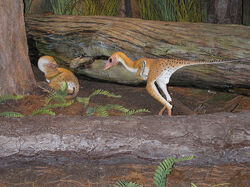| Mei Fossil range: Early Cretaceous | |
|---|---|
 A model of Mei at the Field Museum. | |
| Scientific classification
| |
|
Class |
|
|
Superorder |
|
|
Order |
|
|
Suborder |
|
|
Family |
|
|
Genus |
|
| |
Mei ('soundly sleeping') is a genus of duck-sized troodontid dinosaur first unearthed by paleontologists in Liaoning, China in 2004. Mei lived during the Early Cretaceous Period. Its binomial name, Mei long means 'Long, soundly sleeping'.
The type fossil is complete and exceptionally well preserved in three-dimensional detail, with the snout nestled beneath one of the forelimbs, similar to the roosting position of modern birds. This posture provides another behavioral link between birds and dinosaurs.[1] The chemistry of the matrix stone and the resting pose indicate the living animal was probably buried instantly in volcanic ash.
Mei has the shortest genus name of any dinosaur, surpassing the previous record-holders Minmi, an ankylosaur discovered in Australia, and Khaan, an oviraptorid from Mongolia.
Description[]
The type fossil is a young juvenile about 53 centimetres (21 in) long, complete and exceptionally well preserved in three-dimensional detail, with the snout nestled beneath one of the forelimbs and the legs neatly folded beneath the body, similar to the roosting position of modern birds. This posture provides another behavioral link between birds and dinosaurs.[1] The chemistry of the matrix stone and the resting pose indicate the living animal was probably buried instantly in volcanic ash. A second specimen, DNHM D2154, was also preserved in a sleeping posture.[2]
Mei is notable as a distinct species of troodontid based on several unique features, including extremely large nares. It is most closely related to the troodontid Sinovenator, which places it near the base of the troodontid family.[1]
As a basal troodontid, unlike advanced troodontids, it has a bird like hip structure shared with many advanced maniraptorans.
Paleoecology[]
Mei lived in the Early Aptian stage of the Cretaceous period, about 125.8 million years ago. At this time, the Liaoning area was dominated by numerous volcanoes in a landscape that was covered in coniferous forest, with an understory of ferns and other plants like large horsetails. Several other trees were present, such as ginkgos and araucarias. Some of the earliest flowering plants were also found here. Rivers and streams coming down from the flanks of the volcanoes fed into lakes in the valleys.
There were many species of small birdlike theropod dinosaurs living in the area, although most of them were slightly larger than Mei. This probably led to a lot of niche partitioning. There were only five or six species of herbivorous non-theropod dinosaurs, however, and a large and varied fauna of early mammals and pterosaurs. The apex predator was the 9-meter-long tyrannosauroid Yutyrannus, which would have preyed on the two or more species of sauropod. Often, volcanoes erupted, entombing animals in ash and suffocating others with carbon monoxide, which accounts for the high level of preservation of fossils.
Mei probably fed on small lizards and insects on the forest floor. It probably climbed trees as well to shelter from larger predators, and was probably not omnivorous. Judging by the length of the legs, it was a fast runner. Nothing is known about its nesting habits.
When the first fossil of Mei was discovered, scientists were charmed to see the fossil in a birdlike sleeping posture. Mei long means 'sleeping dragon' in Chinese. The animal had probably died from carbon monoxide poisoning, then became entombed in ash.
In popular culture[]
Mei long were featured in the third episode of the ITV series Prehistoric Park, where they were depicted attacking a member of the fictional documentary crew, looking for the food in his pack. In the story, several M. long were later found dead near a volcano, suffocated by the toxic gasses, based on one hypothesized explanation for the 'sleeping' posture of the fossil.[3] The program also erroneously depicted Mei without feathers and coexisting with the dromaeosaurid Microraptor, which lived later and is known from younger rocks of the Jiufotang Formation, rather than the older Yixian Formation where Mei was found.
References[]
- ^ Xu and Norell, (2004). "A new troodontid dinosaur from China with avian-like sleeping posture." Nature, 431: 838-841.
External links[]
- Troodontidae from Thescelosaurus